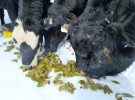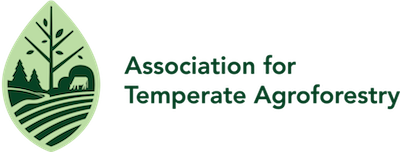| |
Hello Visitor,
Welcome to the Spring 2020 version of the Temperate Agroforester. The newsletter welcomes contributions for future issues and input or feedback about anything that you read in this issue.
Christine Nieman, Callie Maron, and Jennifer Ghigiarelli Editors - Temperate Agroforester
Events
Call to Action
AFTA needs you! We need your research updates, blog posts, news items and other information to inform our followers. Contact: Andres Anchondo. We are also looking for volunteers to help with membership engagement and website content. Volunteer today to help keep AFTA moving foward.
Membership
Are you a member of AFTA? If not consider joining by clicking here. Your membership gives you access to the members-only area, discounts on conference registration, and helps support AFTA's mission to promote agroforestry.
Contents
Shana Hanson, 3 Streams Farm, Belfast, ME
 Leaf fodders tested in the lab included 8 species of chipped leafy branch silages, hand-stripped leaf silages, and dried leaves from tarped leafy branch piles. These fodders were produced as part of SARE FNE18-897, a two-year study, which created and described a 1-acre Demo Plot of “air meadow” tree canopy harvest (Figure 2 below). This project measured yield, labor hours, and goat consumption rate; and recorded cattle, sheep, goat and hog responses to various fresh and stored tree leaf fodders (Figure 3 below). The SARE FNE18-897 Final Report can be found at: SARE FNE18-897 Final Report. A 2019 University of Vermont mini-grant funded nutritional testing of winter-stored tree leaf fodders. The Final Report can be found here.
Read More
Sarah E. Coffey, John F. Munsell, Rico Hübner Department of Forest Resources and Environmental Conservation at Virginia Polytechnic Institute and State University, TUM School of Life Sciences Weihenstephan, Technical University of Munich, Freising, Bavari
 Food forestry intentionally integrates food-producing trees and shrubs in built environments to bolster community resilience (Clark and Nicholas 2013). Examples include public orchards and community food forests (Figure 1; Figure 2). Food trees as part of urban blue-green infrastructure enhance important ecosystem services such as providing shade, reducing runoff by stabilizing soils, and increasing biodiversity while simultaneously providing access to nutrients that are absent from many American diets (Lafontaine-Messier et al 2016; Clark and Nicholas 2013). In the last two decades, there has been an increase in urban agroforestry projects primarily in large metropolitan areas in North America and Europe (Bukowski and Munsell 2018; Hübner et al 2018; Clark and Nicholas 2013), but little is known about its use in smaller towns.
Read More
Sangita Karki, Raymon Shange, Ramble Ankumah, Wendell McElhenney, Osagie Idehen, Sanjok Poudel, Uma Karki; Tuskegee University, Virginia Polytechnic Institute and State University
 Soil physiochemical properties and enzyme activities are often considered as important indicators of the soil health dynamics in various land-use systems (Bunemann et al. 2018). Soil physiochemical properties and enzyme activity also significantly impact the presence and activity of the soil microorganisms. Therefore, activities of soil enzymes are important in assessing ecosystem functioning. Land-use is a key driver of soil physiochemical properties and enzyme activities and is one of the major factors influencing biodiversity and ecosystem functioning (Lange et al. 2015; Sala et al. 2000). Silvopasture, an agroforestry practice that combines trees with forage and livestock production, has recently gained prominence as an ecologically sustainable and environmentally desirable land-use system (Haile et al. 2008). This form of a sustainable land-use system is gaining popularity in the southeastern United States. The southeastern United States holds considerable potential for developing the silvopasture system as it has mild and moist climatic conditions suitable for commercial timber and grazing livestock production (Rietveld & Francis 2000). As forest-use land constitutes 61.9% of the total land area in the southeast, the rapidly emerging concept of silvopasture is believed to have an economic impact on producers in this region. However, its impacts on soil properties remain unexplored. Limited studies have reported the impact of change in existing woodland to a silvopasture land-use system on soil physiochemical properties (Staley et al. 2008). Recently, research focused on enzyme activities in forest ecosystems (Saiya-Cork et al. 2002; Xu et al. 2015; Yin et al. 2014) have emerged, however, only countable studies on enzyme activities in silvopastoral management are documented. Therefore, this study aimed at comparing the selected soil enzyme activities and soil physiochemical properties of southern-pine silvopasture and southern-pine/hardwood mixed woodland systems.
Read More
Christine Nieman, Valens Niyigena, Amanda Ashworth, Taylor Adams, Dirk Philipp, and Ken Coffey USDA-ARS DBSFRC, Booneville, AR Univ of Arkansas Dep of Animal Science, Fayetteville, AR USDA-ARS PPPSR Fayetteville, AR
 In silvopasture systems, plant physiology and forage management are important for overall productivity and profitability of the system. This may be especially important when considering forage utilization by grazing ruminants. Soluble sugars or water soluble carbohydrates (WSC) may influence cattle preference and selectivity of forages in a grazing system (Horadagoda et al., 2009). This desire to select may be behavior drivers for ruminants, causing them to selectively graze certain species or areas of the pasture during specific seasons and times of the day. Various physiological, environmental, and management factors including fertilization, time of day, season, and warm- vs cool-season species effect WSC concentrations. Understanding these factors and WSC is especially important in silvopasture systems that may contain alleys of cool- and warm-season species. Therefore, researchers at USDA ARS Poultry Production and Product Safety Research sought to examine the effects of these management strategies on WSC concentrations in a silvopasture near Fayetteville, AR (Figure 1 and Figure 2).
Read More
Ronald S. Revord and Michael A. Gold, University of Missouri Center for Agroforestry.
 Over the past 25 years, U.S. chestnut cultivation for nut production has increased through grower-led advancement. In the Midwest, a predominant reason for this growth is the long-standing, steady progress made by exceptionally dedicated growers and University of Missouri partners to develop regional markets. Grassroots chestnut production over the past decade has led to the successful establishment of multiple farmer cooperatives (e.g., Michigan, Ohio, Iowa) and many new regional markets in the Midwest. Multiple years of market research indicate that annual demand exceeds supply (Gold et al. 2006; Gold and Cai 2019) and that chestnut cultivation must expand accordingly. In fact, the number of chestnut farms in the United States grew by 57 percent from 2012 to 2017, while hundreds of other orchards are approaching mature bearing years, including over 400 new chestnut farmers in midwestern and neighboring states (NASS, 2017).
Read More
James Allen, Northern Arizona University
 Recently I purchased a copy of RetroSuburbia: The Downshifter’s Guide to a Resilient Future, by David Holmgren (Figure 1). At the time I was not really thinking of this book in the context of agroforestry and especially not in the context of the COVID-19 pandemic, but I have come to think of it as being quite timely in both cases.
Read More
Jacob Grace, Outreach Coordinator, Savanna Institute
 Farmers who plant productive trees between row crops to diversify yields, reduce erosion, protect wildlife habitat, and store carbon have a new source of potential support, thanks to funding made available by The Nature Conservancy’s Natural Climate Solutions Accelerator Program and the Doris Duke Charitable Foundation. This February, $250,000 was awarded to the Savanna Institute, which will in turn provide support to participating farmers implementing alley cropping on their land (Figure 1). The Accelerator Program is funded through a generous grant from the Doris Duke Charitable Foundation.
Read More
Bussoni Adriana1, Munka Carolina1, Boscana Mariana1, González Ana1, Rachetti Marcello2. 1Agronomy College - Universidad de la República - Udelar. 2Comisión Nacional de Fomento Rural
 Forests for shelter and shade on rural farms provide service to livestock and mitigate erosive processes, among other environmental services, and allow producers to diversify their income. The incorporation of forests on the land is an activity that requires specialized knowledge and skills, and financial resources (Mercer 2004). Despite the potential in terms of production and income improvements, the adoption of these systems is generally low in Latin America. Thus, in Chile, family producers present 4% afforested on average production of 50 ha (Sotomayor 2010). In Uruguay, an estimated of 9% of livestock is raised on forested land (Bussoni et al. 2017) and the forests for shelter and shade occupy 8% of the planted 1 million ha or 2.47 million acres (MGAP 2019). There are various incentives to introduce trees to livestock farms in Latin America (Calle et al. 2012) such as subsidies, credits, and payment for environmental services. From 2008 to 2013 (MGAP 2008; MGAP 2013), partial subsidies were granted to incorporate forests to improve the adaptation of livestock activity to climate variability and promote improvements in global farm productivity. This study utilizes five case studies to explore the potential of these forests to improve income, and 55 case studies to examine the main difficulties when implementing forests through semi-structured interviews.
Read More
|
|








